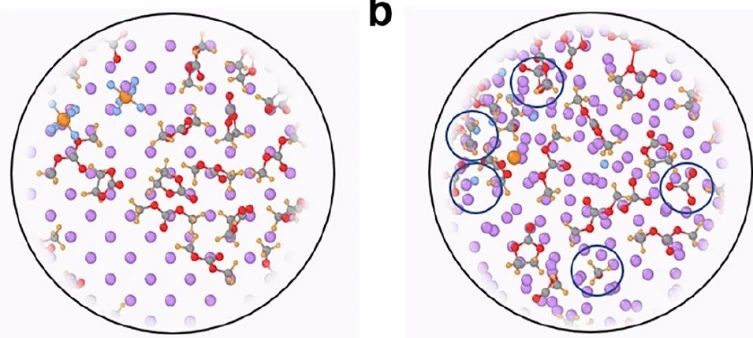海归学者发起的公益学术平台
分享信息,整合资源
交流学术,偶尔风月

锂金属被认为是高比能电池的理想负极材料。然而,其实际应用受到安全性和循环性能较差的阻碍,而这两者都严重依赖于锂金属与电解液之间复杂的界面。具体而言,其上发生的多种相互交织的化学和电化学过程使得对该界面的根本理解变得复杂。近年来,不断发展的先进表征技术和计算方法已被证明是研究锂金属负极界面的有效工具,例如提供反应中间体/产物的化学/结构信息。尽管这些方法在一定程度上增进了我们对锂金属负极界面的理解,但目前仍缺乏对界面上发生的电化学和化学反应的深入分析。此外,目前还没有关于这些反应对锂枝晶生长影响的讨论。对于锂金属负极的实际应用而言,精确模拟这些复杂的反应并了解它们对锂枝晶生长的影响至关重要。
图1.耦合电荷的矩张量势模型示意图
来自北京大学新材料学院的郑家新团队,开发了耦合电荷的矩张量势(QMTP)模型,并基于该模型建立了对锂金属负极界面上发生的电化学和化学反应的分子水平的理解。该研究为从根本上理解锂金属与电解液界面上发生的相互交织的过程提供了可能,并为锂金属与电解液界面设计提供了新的见解。
图2.基于QMTP模型与相场模型的锂金属界面反应与枝晶生长的多尺度模拟
他们基于多尺度模拟将界面反应与锂枝晶生长相关联,探索了电荷转移如何引发界面反应以及受不同电解液浓度的影响,发现了初始反应中更快的电荷转移动力学有利于控制锂枝晶的生长。另一方面,在较高浓度电解液下,生成了更多的LiF等无机产物,并且形成了更致密的堆积层。与低浓度电解液相比,高浓度电解液下锂金属负极被氧化的趋势更强,导致总电荷快速增加。该研究将机器学习势场与相场模型相结合,从而能够更加全面理解锂金属负极上的界面反应和锂枝晶生长。研究表明了锂枝晶的生长可以通过界面反应来调节,而界面反应受到锂金属与电解液界面上发生的电荷转移的影响。此外,电荷转移动力学被视为一种描述符,可以解释界面上这些行为背后的驱动力。
图3.界面反应与锂枝晶生长关联机制示意图
这些对界面反应的见解有助于在锂金属负极上设计和构建稳定的界面结构。该研究还显示出通过结合机器学习驱动的分子动力学和相场建模的多尺度模拟技术来弥合实验和模拟研究差距的巨大潜力。该文近期发表于npj Computational Materials 11::121 (2025),英文标题与摘要如下,点击左下角“阅读原文”可以自由获取论文PDF。
Unraveling charge effects on interface reactions and dendrite growth in lithium metal anode
Genming Lai, Yunxing Zuo, Chi Fang, Zongji Huang, Taowen Chen, Qinghua Liu, Suihan Cui & Jiaxin Zheng
Li metal is acknowledged as an ultimate anode material for high-specific-energy batteries, although its safety and practical cyclability heavily depend on the mysterious interface between Li metal and liquid electrolyte (LLI). However, there are substantial gaps in understanding the multiple intertwined chemical and electrochemical processes occurring on the LLI. Here, we unprecedentedly present the disentangled analyses of these processes and correlate them with Li dendrite growth by multi-scale simulation techniques combining machine-learning-driven molecular dynamics and phase-field modeling. Our simulations demonstrate a close relationship between Li dendrite growth and the interface reactions, which can be attributed to the charge transfer process. We further reveal that the behaviors of bond cleavages can be regulated by varying charge distribution at the interface. We propose that the charge transfer kinetics, revealed by the newly developed formulism of machine learning potential incorporating charge information, can act as a descriptor to explain the driving forces behind these behaviors on the LLI. This work enables new opportunities to fundamentally understand the intertwined processes occurring on the LLI and provide crucial new insights into the electrode-electrolyte interface design for next-generation high-specific-energy batteries.
